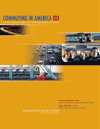The Washington region is third only to New York and Chicago for the percentage of workers with “extreme commutes,” defined as 60 minutes or more each way, according to “Commuting in America III,” published by the Transportation Research Board. (For a snappy summary of the findings, read the coverage in the Washington Post.)
The study offers an abundance of data about commuting trends. (Read a digest of cool commuter facts here.) Work travel constitutes only 16 percent of total travel. (Ever notice how congested it’s getting on Saturdays?) … Because most immigrants are working age, they’re more like to drive to work. Hispanic immigrants also are more likely to carpool…. Commuting from suburb to suburb now accounts for 46 percent of all commuting…. Driving alone continues to increase, while walking to work is declining precipitously…. Average commute times have increased from 21.7 minutes in 1980 to 25.5 minutes in 2000….
Of particular interest to me is the “extreme commuting” number. Here are the rankings for major Virginia metro areas:
3. Washington, 12.83 percent of commuters
33. Hampton Roads, 4.89 percent of commuters
38. Richmond, 4.46 percent of commuters
Of the 12 counties with the highest percentage of long commutes in the country, the Washington area has three: Prince William, Va., and Prince George’s and Montgomery in Maryland.


Leave a Reply
You must be logged in to post a comment.